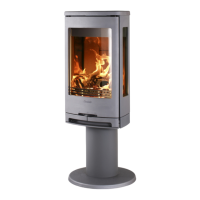GB
31
Lighting Instructions
Possible causes of
malfunctions and how to
rectify them
Poor draft in the stove after new installation
• Check the dimensions of the chimney so that they correspond to the
ones stated in the installation instructions.
• Check that there is nothing in the chimney to restrict the smoke and
that no nearby buildings or trees affect the winds around the chimney.
It is diffi cult to light the fi re and the fi re dies after
a short time
• Check that the wood is sufficiently dry.
• Too great a negative pressure in the house, for example when using
a kitchen extractor fan or other mechanical ventilation. Open a
window near the hearth before lighting the fire. Also try lighting some
newspaper and holding it up inside the firebox to get the draft going.
• The supply air duct from outdoors can be partially or totally blocked.
Remove the hose and try test lighting with combustion air from the
room.
• Check that the combustion air damper is open.
• The smoke outlet of the stove may be blocked with soot, which can occur
after sweeping.
Lift the smoke baffle out and check.
• Finally, go through the lighting instructions again.
Perhaps the amount of kindling was too small and therefore the base
embers were too weak and cold to light the next load of wood.
Abnormal amounts of soot form on the glass
There is always a certain amount of soot on the glass and this is added to
with each lighting. Soot on the glass is caused by three things:
• The wood is damp, which causes poor combustion and generates a lot of
smoke as a result.
• Too low temperature in the firebox, which causes incomplete combustion
and poor draft in the chimney.
• Handling is not correct, for example the hatch was not in the lighting
position for 5-10 min.
Check the moisture content of the wood, ensure that you have good
base embers and go through the lighting instructions one more time.
Smoke odour around the stove for periods
This can occur when wind blows down the chimney and most often occurs
when the wind is from a particular direction. Another reason could be that
the hatch was opened when there was a lot of flame.
Painted parts have become discoloured
If painted parts have discoloured it is due to excessive temperature in
the firebox. The reason for the excessive temperature can be that the
maximum amount of wood has been used or that inappropriate fuel has
been used (for example building waste, large quantities of finely chopped
off cuts). The warranty does not cover damage of this type. If a problem
occurs that you cannot rectify yourself, contact the dealer or a chimney
sweep.
We hope that these lighting tips give you enjoyable, economical and
problem free use of your Contura stove.
Sweeping
Sweeping the chimney ducts and chimney connections should be carried out by a chimney sweep. Sweep the stove
by scraping and/or brushing. A soot vacuum cleaner is most appropriate however. If a chimney fire occurs or is
suspected, the combustion damper and the door must be closed. If necessary, contact the fire brigade to extinguish
it. The chimney must always be inspected by a chimney sweep after a chimney fire.
• During operation, the surfaces of the stove become very hot and can cause burn
injury if touched.
• Be aware of the strong heat radiated through the hatch glass.
• Placing flammable material closer than the safe distance indicated may cause a fire.
• Pyre lighting can cause quick gas ignition with the risk of damage to property and
personal injury.
• The ash-pan must be emptied when it is full. If this is not done, the air supply can
become blocked, resulting in poor function. In serious cases, ash can find its way
out through the damper.
• Modifications to the stove must not be carried out by unauthorised persons.

